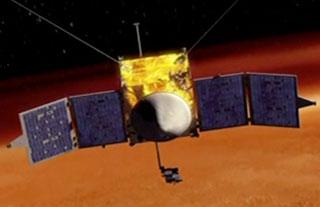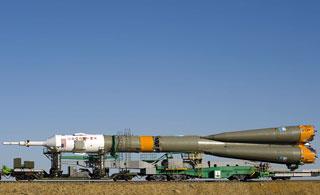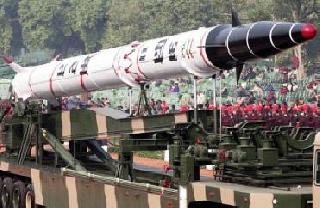
An artist's conception of the MAVEN spacecraft orbiting Mars. Photo: NASA/Goddard Space Flight Center
WASHINGTON (BNS): NASA is planning to launch its Mars Atmosphere and Volatile Evolution Mission (MAVEN) in 2013, to study the Red Planet in-depth.
The $400-million plus project, will study the fast disappearing atmospheric planet of the planet.
NASA has scheduled the launch of the MAVEN between November 18th and December 7th, 2013. If it is launched on November 18th, it will reach Mars on September 16th, 2014 for a year-long mission.
"Previous observations gave us 'proof of the crime' but only provided tantalizing hints at how the sun pulls it off - the various ways Mars can lose its atmosphere to solar activity," Joseph Grebowsky of NASA's Goddard Space Flight Center in Greenbelt, Md. and project scientist for MAVEN, said.
According to NASA, Mars lost its global magnetic field billions of years ago. Once its planet-wide magnetic field disappeared, its atmosphere was exposed to the solar wind, and could have been gradually stripped away.
Compared to Mars, the atmosphere on Earth is thicker and the planet still has a magnetic field that protects it from the solar radiation.
"Mars can't protect itself from the solar wind because it no longer has a shield, the planet's global magnetic field is dead," Bruce Jakosky of the University of Colorado said.
As the atmosphere thinned, the water on the planet evaporated and was lost to space. Increased ultraviolet radiation would also break water into its component atoms of hydrogen and oxygen.
"MAVEN will examine all known ways the sun is currently swiping the Martian atmosphere, and may discover new ones as well. It will also watch how the loss changes as solar activity changes over a year. Linking different loss rates to changes in solar activity will let us go back in time to estimate how quickly solar activity eroded the Martian atmosphere as the sun evolved," Grebowsky added.
Features on Mars resembling dry riverbeds, and the discovery of minerals that form in the presence of water, indicate that Mars once had a thicker atmosphere. However, it was lost due to exposure to solar radiation that quickly boils away water on the surface.
The MAVEN team will measure the amount of hydrogen compared to the amount of deuterium in Mars' upper atmosphere, which is the planet's present-day hydrogen to deuterium (H/D) ratio. They will compare it to the ratio Mars had when it was young -- the original H/D ratio.
The original ratio is estimated from observations of the H/D ratio in comets and asteroids, which are believed to be pristine, "fossil" remnants of the solar system's formation.
The spacecraft will be developed at the Littleton facility center of Lockheed Martin.
 Previous Article
Previous Article Next Article
Next Article













The Indian Air Force, in its flight trials evaluation report submitted before the Defence Ministry l..
view articleAn insight into the Medium Multi-Role Combat Aircraft competition...
view articleSky enthusiasts can now spot the International Space Station (ISS) commanded by Indian-American astr..
view article